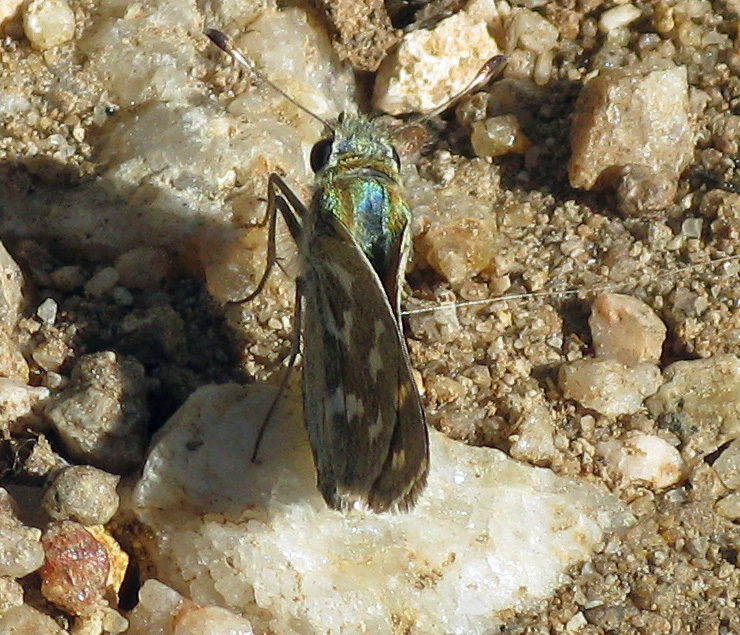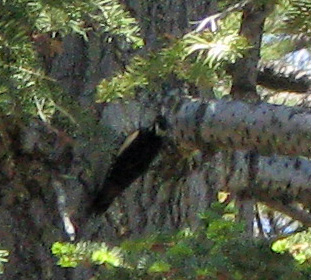#434-437 at Big Bear
It’s funny how many species don’t make the hop over the last desert and mountain range to reach the California Coast. Previously this year I’ve added 10 species to my life list (and several more to my California list) on the far side of the Santa Ana Mountains that border the O.C. on the east. Probably eight of those are uncommon in the county at best. Last weekend I added four more on a Sea & Sage trip to the San Bernardino National Forest on the south side of Big Bear Lake.
I met up with Stan Winterman about 5:30 A.M. in Costa Mesa to carpool out to Big Bear. (Side note: unlike NYC field trips, carpooling out here is the exception, not the rule; and usually just means you drive two hours to the meeting point, then carpool five miles down a dirt road from there. It takes major effort to arrange car sharing, even for long distance trips outside the county like this one. If anyone wants to carpool with me for next month’s trip to Piute Ponds, please holler.) From there it was about a 90-minute drive to Big Bear in the light early morning traffic. My first lifer was on the mountain road up to Big Bear, but it was a mammal, a Coyote. I’ve never actually seen a wild one before, but there it was; standing by the side of the road as bold as anything. Cute too, though I might feel differently if it ate my cat.
The group met at the Aspen Glen Picnic Area. The first thing that struck em when we got out of the car was that this smelled a lot like Sunspot, New Mexico (where I haven’t been for 12 years or so). Not too surprising: it’s very similar habitat on the top of a mountain in the middle of a desert. Both even have solar observatories. However there was one notable difference: the piney smell was mixed with a strong aroma of vanilla. I wondered if some camper had for some strange reason poured a bottle of vanilla extract on the ground or into the trash or some such. However I later leanred that this is actually the smell of the Jeffrey Pine, which is prevalent here, but which I guess we didn’t have back in Sunspot.
The picnic area parking lot was just a convenient place to meet, but it has some birds nonetheless. Apparently Cassin’s Finch (a potential lifer) was seen here on this trip last year, but all we got this year was House Finch. Other common parking lot birds included American Robin, Common Raven, American Robin, Spotted Towhee, Brewer’s Blackbird, and Acorn Woodpecker, but we did find Northern Flicker, Steller’s Jay, and White-breasted Nuthatch. We also found California Ground Squirrel and what I think was a Lodgepole Chipmunk, but I don’t have pictures so I can’t be sure. They’re something like a dozen+ species of chipmunks around here, so ID’ing them is more challenging than the single species we have back east. Final species for the parking lot was this Skipper:

I think the genus is Hesperia, but I’m not sure. Skippers are tough to ID, even with photos.
Around 8:30 we consolidated into mostly high clearance vehicles and headed off down a dirt road (2N10 or 2N11?) that doesn’t show up on Google Maps road to Bluff Lake.
Before we got to Bluff Lake, though, we pulled off by the side of the road and spent about an hour scanning a meadow. There frequent calls from what were either Fox Sparrows or Green-tailed Towhees or both. This would continue throughout the day, but I never saw either one. Other members of the group did see a Fox Sparrow here or there. I don’t think we had any confirmed sightings of Green-tailed Towhees though.
A little easier to spot were the Dark-eyed Juncos. Mountain Chickadees were also working the pines. A Red-tailed Hawk flew over behind the pines. Other birds included Western Bluebird, Band-tailed Pigeon, Common Raven, Violet-green Swallow, Western Tanager, Brown-headed Cowbird, Lincoln’s Sparrow, Red-breasted Sapsucker, and Red Crossbills.
We could have spent quite a bit more time here, but we didn’t want to get to Bluff Lake too late, so we wandered back to the cars (only a couple of hundred meters, we never got very far in here) and continued driving down the road to the entrance to the old YMCA Camp (now owned by the Wildlands Conservancy). This is closed to the public, but we had special permission to walk through on our way to the Champion Lodgepole Pine and Bluff Lake.
About halfway down the road to the camp, one of our group spots a White-headed Woodpecker, my first life bird of the trip.
I swear I had barely gotten my binoculars on the bird when Jim Pike yells, “Pale swallowtail!”
“You’re going to make me choose, aren’t you?” I said.
“You’ve seen White-headed Woodpecker before,” he replied.
“No I haven’t. I’m from the East Coast. This is my first.”
“Oh well, you’ll see others,” he says.
This was to be a common theme throughout the day. The butterflies and other insects along the trail were just as prevalent and exciting as the birds. We saw multiple species of Whites, Blues, Checkerspots, Sulfurs, Bluets, and many bees, ants, and wasps we’ve yet to identify. You often didn’t know whether to look up or down.
After we reached the camp and greeted the ranger, we took a side trip off into a meadow that was just packed with ants, wasps, and birds. Unfortunately I missed half the birds including the Lawrence’s Goldfinch and a Townsend’s Solitaire! Damn, that would have been a lifer. There’s just too much to look at.
About 11:30 we entered the old YMCA (now Wilderness Conservancy) camp. Off to the left of the trail I spotted some finches, and after studying them for a bit we decided they were Cassin’s Finches, my second lifer of the day, and #435.
Around the same location, Bettina, who’s trailing behind, hears a Chipping Sparrow. No one’s sure, so I trot back down the trail to where she saw it. It’s hidden in a bush, but it is indeed a Chipping Sparrow, rufous cap and all.
Ten minutes later Bettina spots a Williamson’s Sapsucker. That’s my third life bird of the day and my fourth sapsucker species in California this year. (Who knew there were that many sapsuckers? Back east we only have the one.) This one has a much yellower belly than a Yellow-bellied Sapsucker, and frankly deserves the name a lot more. On the Yellow-bellied Sapsucker you’re lucky if you can even make out a pale wash of yellow. This one’s a bright banana yellow like on a Western Kingbird.

At 12:00 we reach Bluff Lake. It’s not more than a large pond, really, but it does host a number of breeding Brewer’s Blackbirds, a Red-winged Blackbird or two, and Gadwall. The camp ranger tells us he’s also seen Blue-winged Teal there, but we never find them. On the trip back we do find the Cinnamon teal though.
About 12:30 we arrive at the Champion Lodgepole Pine. No one’s quite sure what qualifies it as the champion. Is it the largest in the forest? the county? the state? the world? Or is it just that someone put a sign in front of it? Either way, it’s pretty big.
Continuing down the path to the ?hammock?, we hear some Red-breasted Nuthatches calling, then some Ruby-crowned Kinglets. It takes a while, but we do eventually see the kinglets. Five minutes later, a Townsend’s Solitaire is spotted. These are moderately secretive birds, so this is a good find, and my fourth lifer of the day, #437. I’m no longer so concerned about missing the one earlier.
We stop for lunch at The hammock (not sure of the name) where some Fox Sparrows are singing, but I never see one, though others in the group do. Around 1:00 we turn around and head back at a leisurely pace. Mostly it’s the same birds again, but we do add Olive-sided Flycatcher to the list. This isn’t a lifer for me, but it is the first tiem I’ve seen one on the West Coast.
As we cross by Bluff Lake again, our final bird of the day is a Pine Sisking feeding in the mud:
This is another new California species for me, and only the second time I’ve seen one. (the first was just last Thanksgiving in Prospect Park.) This is a much nicer specimen, obviously not a goldfinch:
My total avian species count for the day was 38 plus a couple of mammals:
- Gadwall
- Mallard
- Cinnamon Teal
- Cooper’s Hawk
- Red-tailed Hawk
- American Coot
- Band-tailed Pigeon
- Mourning Dove
- Acorn Woodpecker
- Williamson’s Sapsucker
- Red-breasted Sapsucker
- Hairy Woodpecker
- White-headed Woodpecker
- Northern Flicker
- Olive-sided Flycatcher
- Western Wood-Pewee
- Steller’s Jay
- Common Raven
- Violet-green Swallow
- Mountain Chickadee
- Red-breasted Nuthatch
- White-breasted Nuthatch
- Ruby-crowned Kinglet
- Western Bluebird
- Townsend’s Solitaire
- American Robin
- Wilson’s Warbler
- Spotted Towhee
- Chipping Sparrow
- Dark-eyed Junco
- Black-headed Grosbeak
- Red-winged Blackbird
- Brewer’s Blackbird
- Brown-headed Cowbird
- Cassin’s Finch
- House Finch
- Red Crossbill
- Pine Siskin
There were a few other species picked up by the rest of the group I didn’t see. I’m stilling tallying all the insects. Most of them have yet to be conclusively identified. This was a gorgeous area overall, and I hope I get some more time to spend here in the future.

June 30th, 2008 at 1:02 AM
The Champ is indeed the largest lodgepole pine in the world (as far as is known). It’s thought to be more than four centuries old.